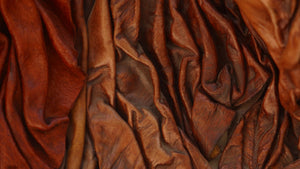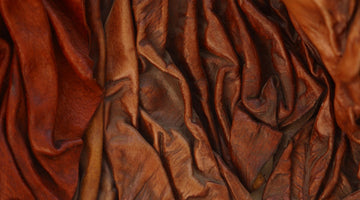Are you about to embark on a creative project with leather but don't know how to choose leather for the job? Are you new to the world of leather manufacture and need some help getting to know which leather is best for which purpose?
Then step forth and get ready to feast on this knowledge.
The type of leather that is best for your project will ultimately depend on what you are doing. Let's learn more.
What Might Influence Your Choice?
When wondering how to choose leather, the most important thing to ask yourself at the beginning of this enterprise is what type of use you hope to get out of the leather as well as the context within which you will be using it.
Think also about:
- The type of tanning - e.g. vegetable-tanned leather, chrome-tanned leather, etc.
- Animal species and breed
- Size of the skin overall
- Leather thickness
- Overall finishing of the surface
Once you have ascertained your intention, perhaps you will ask yourself what type of leather is best.
Well, What Type of Leather is Best?
Well, seeing as there is no one answer that fits all queries, we might as well stop the investigation, right? Wrong! There are certain leathers that are better suited to different tasks.
The grain leather that you decide to use will have everything to do with the specific task you have in mind. So, if you haven't already ascertained your intention return back up there to the first step before you decide whether you want to use full-grain leather, top-grain leather, split leather, etc.
Best Leather for Furniture and Upholstery
Upholstery leather is typically produced through cattle, the larger the better, though also preferably with a low thickness and a soft temper. This leads to a product that is characterized by its uniform and resistant finish, making it perfect for upholstery projects like sofas, car interiors, furniture, etc.
In terms of numbers, leather for this purpose is recommended to be around 1 - 1.5mm thick and in turn larger than four square meters (40 square feet). It can be difficult to always achieve these same requirements for every piece of upholstery, hence why faux leather is often called upon to do the job.
Best Leather for Bags, Wallets, Crafts, etc.
Leather for these purposes is ideally made from a higher quality - oil-tanned leather, yes, bonded leather, not really. This usually means that it is made from bovine or sheep hides which are altogether better suited to making bags, totes, suitcases, wallets, bindings, covers, accessory cases, and clutches.
The thicknesses of these items can be far higher than that of leather upholstery, being made from smaller hides of genuine leather, with thicknesses ranging from 1mm to 2.5mm (at 2-5 oz.). Though bovine and sheep leather are commonly used, a whole variety of possibilities are open to the manufacturer including half calves, shoulders, whole calves, lamb skins, and bellies.
Best Leather for Shoes and Footwear
The types of leather used for the manufacture of shoes and footwear are typically centered around calfskin and sheep.
The quality can vary considerably but is generally lower than for other leather goods. This slight dip in quality, however, should be contrasted with an overall greater resistance to wear, bending, and other atmospheric agents.
Footwear is typically made either from:
- Full-grain leather, maintaining the characteristic of the grain, being opaque, shiny, or printed.
- Split leather, obtained from the underside of the leather to achieve a classic suede effect.
Best Leather for Clothing and Garments
The leather used for clothing and garments is typically soft, light, and fine, most often made from the skins of sheep or goats. These latter two varieties are best suited to making gloves, skirts, jackets, coats, and various other types of garments thanks to their adherence to the qualities outlined above.
For this purpose, leather thicknesses between 0.4mm and 1mm (1-3 oz.) are recommended, both from the body of a sheep and/or a calf.
Best Leather for Saddles
The leather used for belts and saddles is usually bovine, ultimately characterized by a far more generous endowment of thickness.
They are also typically veg-tanned leather, though this isn't to stop anyone using the chrome tanning process from getting the job done, though these will typically be of lower thicknesses. This is actually quite useful when trying to craft the saddle of, say, a motorbike which inherently needs a thinner seat.
For this purpose, the most common leathers used are undoubtedly those sourced from the shoulders or butts of the bovine creature in question, often vegetable-tanned in thicknesses ranging from 2mm to 5mm (5-13 oz.) overall.
Best Leather for Making Wallets
Wallets can be made from a whole variety of different leathers - some even being made from synthetic leather - though there are three main types that are favored by most manufacturers:
Chrome-tanned calfskin that can achieve a luxurious and uniform look
Vegetable-tanned bovine shoulder will sport thicknesses from 1mm to 2mm (2-4 oz.), providing a more artisanal air to the finished product
Premium goatskin has been known to also provide a more refined texture and, in turn, a softer hand to the end product
Best Leather for Belts
The general consensus among leather aficionados is that belts are best when made from the vegetable-tanned double shoulders or double butts of a bull. This means that the thicknesses can range from 3mm to 5mm (8-13 oz.), some of the thickest on this list entirely.
These parts of the animal present a remarkable quality to the grain while also providing the generous size and square shape needed to manufacture leather belts with as little waste as possible. Leather furniture manufacturers could learn a thing or two from this philosophy.
Best Leather for Knife Sheaths
Leather for knife sheaths needs to be pretty darn thick to ensure that no one gets stabbed accidentally. For this same reason, it needs to be resistant and rigid, so larger leather isn't exactly necessary.
Aficionados will thus recommend the use of bovine hides that have been vegetable-tanned to ensure their thickness and robustness.
Once this part of the process has occurred, effects are obtained after the fact by printing or engraving decorations onto natural-colored leather. This same thing can also be done by dying it during the tanning process or even by hand. Don't be afraid to mix your tanning processes for some interesting results here!
Choosing the Right Vegetable-Tanned Leather
This tanning process, if you aren't already familiar with it, is characterized by its distinct use of only natural substances to get the job done.
When choosing, though, careful attention must be given to the finish, size, and relative thickness of the leather in relation to the project you have in mind for it.
These leathers are often utilized in their unfinished form, versatile, and open to the prospect of customization options like fattening, engraving, or dyeing.
Choosing the Right Leather Scraps
Otherwise known as leather remnants, cuttings, or leftovers, leather scraps are a great way to make something new from the old while also doing the environment a favor. This is ultimately a waste product, after all, and would otherwise go to landfill, regardless of whether it is suede or nubuck leather.
The most important thing you need to do when choosing from these scraps is to refer to the guide above to ensure you get the right type of leather for you, but also to check that the sizing is appropriate for your purposes.
Final Words
So, there you have it! Hopefully, you have a better idea of what you now need to get started manufacturing your own leather items.
FAQs How to Choose Leather
HOW DO I CHOOSE GOOD QUALITY LEATHER?
The quality of leather is often relative to the specific purpose you have in mind for it. Ascertain your intentions and return back here when you have done so.
HOW TO CHOOSE LEATHER?
Choosing leather can be difficult unless you know what it is you want out of it. The most important thing you can do for choosing leather is to know what you want.



